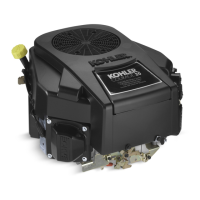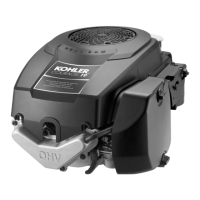40
Disassembly/Inspection and Service
KohlerEngines.com 18 690 01 Rev. B
Remove Camshaft and Valve Tappets
1. Remove camshaft by pulling it straight out of
crankcase.
2. Remove valve tappets by pulling straight out of
crankcase. Mark their positions.
Inspection and Service
Inspect gear teeth of camshaft. If teeth are badly worn
or chipped, or if some are missing, replacement of
camshaft will be necessary. If unusual wear or damage
is evident on either camshaft lobes or mating tappets
camshaft and both tappets must be replaced. Check
condition and operation of Automatic Compression
Release (ACR) mechanism.
Automatic Compression Release (ACR)
ACR Operation Details
B
C
E
D
A
A Camshaft B Exhaust Cam Lobe
C
Decompression
Weight
D Return Spring
E Arm
These engines are equipped with an ACR mechanism.
ACR lowers compression at cranking speeds to make
starting easier.
Operation
ACR mechanism consists of a decompression weight
and arm mounted to camshaft, and activated by a return
spring. When engine is rotating at low cranking speeds
(1000 RPM or less), decompression weight holds arm
so it protrudes above heel of exhaust lobe. This holds
exhaust valve off its seat during fi rst part of compression
stroke.
After engine speed increases above approximately 1000
RPM, centrifugal force causes decompression weight
to move outward, causing arm to retract. When in this
position, arm has no effect on exhaust valve and engine
operates at FULL compression and power.
Benefi ts
As a result of reduced compression at cranking speeds,
several important benefi ts are obtained:
1. Manual (retractable) starting is much easier. Without
ACR, manual starting would be virtually impossible.
2. Electric start models can use a smaller starter and
battery that are more practical for application.
3. ACR eliminates need for a spark retard/advance
mechanism. A spark retard/advance mechanism
would be required on engines without ACR to
prevent kickback that would occur during starting.
ACR eliminates this kickback, making manual
starting safer.
4. Choke control setting is less critical with ACR. If
fl ooding occurs, excess fuel is blown out opened
exhaust valve and does not hamper starting.
5. Engines with ACR start much faster in cold weather
than engines without ACR.
6. Engines with ACR can be started with spark plugs
that are worn or fouled. Engines without ACR are
more diffi cult to start with those same spark plugs.
Remove Piston, Connecting Rod, and Crankshaft
NOTE: If a carbon ridge is present at top of cylinder
bore, use a ridge reamer to remove it before
attempting to remove piston.
1. Remove screws securing end cap to connecting rod.
Remove end cap. While guiding connecting rod,
slide piston and connecting rod from cylinder bore.
2. Remove crankshaft from crankcase.
Connecting Rod Inspection and Service
Check bearing area (big end) for excessive wear, score
marks, running and side clearances. Replace connecting
rod and end cap if scored or excessively worn.
Service replacement connecting rods are available in
STD size.
Pistons and Rings Inspection
Scuffi ng and scoring of pistons and cylinder walls occurs
when internal engine temperatures approach welding
point of piston. Temperatures high enough to do this are
created by friction, which is usually attributed to improper
lubrication and/or overheating of engine.
Normally, very little wear takes place in piston boss or
piston pin area. If original piston and connecting rod can
be reused after new rings are installed, original pin can
also be reused but new piston pin retainers are required.
Piston pin is included as part of piston assembly; if pin
boss in piston or pin itself is worn or damaged, a new
piston assembly is required.
Ring failure is usually indicated by excessive oil
consumption and blue exhaust smoke. When rings fail,
oil is allowed to enter combustion chamber where it is
burned along with fuel. High oil consumption can also
occur when piston ring end gap is incorrect, because
ring cannot properly conform to cylinder wall under this
condition. Oil control is also lost when ring gaps are not
staggered during installation.
When cylinder temperatures get too high, lacquer and
varnish collect on pistons, causing rings to stick, which
results in rapid wear. A worn ring usually takes on a
shiny or bright appearance.
Scratches on rings and pistons are caused by abrasive
material such as carbon, dirt, or pieces of hard metal.

